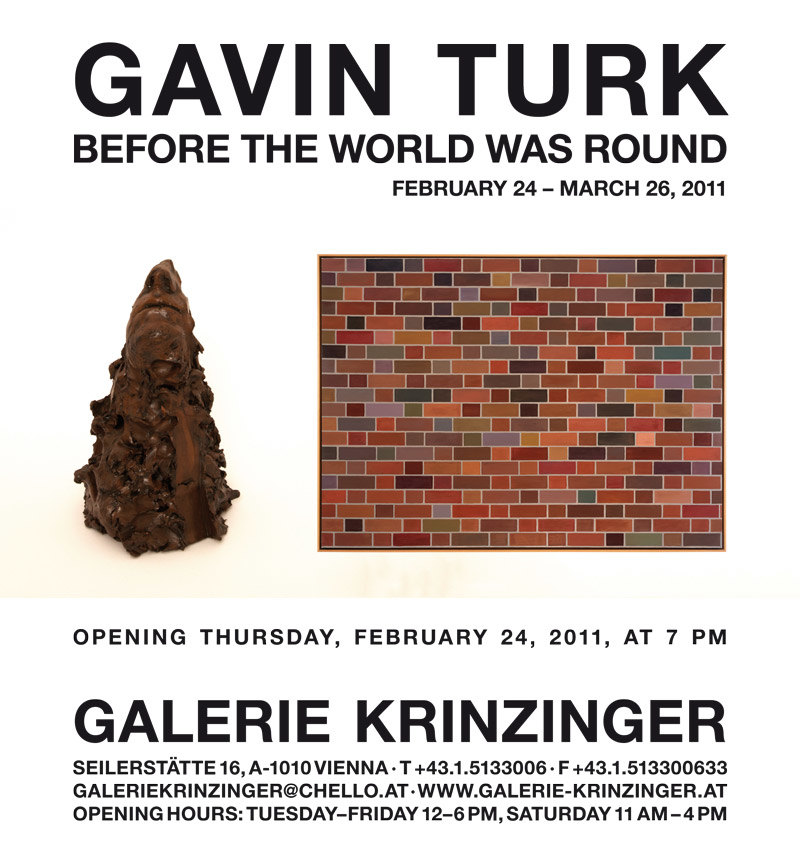News2011Before The World Was Round, Galerie Krinzinger Solo Show

18.02.2011
Before The World Was Round, Galerie Krinzinger Solo Show
Before The World Was Round
Galerie Krinzinger, Seilerstatte 16, A-1010 Vienna, Austria
Private View: 7pm 24th February 2011
Open: 24th February - 26th March 2011
Looking through the wrong end of a telescope at a mirror: the sailor at sea gazing at the endless horizon looking for land. The reflection both tiny and far away and yet up close and familiar and endlessly repeating. The energy and exuberance dancing from these colourful pieces celebrating the confident denial of originality. Steeped in recycling and rhetoric the work plays with the tragedy and abject nihilism of a culture in search of an identity. The UK’s once proud island of sailors, warriors, farmers and traders reduced to ‘whitevanman’ and wannabe revolutionary radical. British heritage objectified to cliché and caricature by the residual tourism industry, deconstructed by Punk and subsumed by the American cultural tsunami surfed so adeptly by Warhol. To lighten the journey, the quirky surrealist sensibility of the Europeans offers the artist a submarine to explore the depths of this capitalist ocean like a contemporary Jules Verne.
The title of the show comes from an image at its heart of a map of the world. This one traced in the lines and patterns of peeling paint as if on a cell wall. The nation of sailors reduced to a prison full of supermarket shoppers. The tapestry of the flattened global map created from pieces of refuse. The detritus of our consumer culture. Most works in the show play with the transcription of dimensions, 3D to 2D or vice versa. The surface to the form or the form to the surface – the contents lost in brand packaging.
This exhibition is full of new works made in the last six months punctuated with pieces from 2003 to 2008. British Culture may have lost its manufacturing industry but the artists studio is alive with technical pyrotechnics and pirouettes. The art reduced to a pile of Ash (2008) about the amount of mass in a human form. The deathly theme permeates the work with the detritus of casualty and accident evident in the transitvan crashes - Transit Disaster Red (2010), as the pre-technological working class symbol is given the Warhol gaze. The frustrated evidence of a revolution that never occurred. Social justice and liberation captured like an insect in amber as a London Brick Missile (2010) is given the artists signature painted bronze treatment. The Beach (2010) is a rubbing from a pavement before the people rise up to reveal the sand beneath. The desert island beneath the streets of Britains surface civilized urban land. The absurdly popular tourist pastime of rubbing brasses or memorial plaques in cathedrals reduced to the street art culture that the British tourist industry increasingly maps onto its itinery like the desperate act of a youth with a spraycan. The detritus of the street is again given iconic stature through the painted bronze iconography of Pavement (2008) as a section of broken concrete pavement is immortalized in the bronze nectar of Art and given a surface skin of oil paint eye trickery.
What you see is what you don’t see is a recurring theme in Turk’s work. In this age of screens, Leon Battista Alberti De pictura (1435), where he famously instructed painters to consider the frame of the painting as an open window, is particularly poignant. These pieces are full of games around perception. Looking at surfaces but seeing metaphors. The audience thinking one reality but that on closer inspection of the materials proves to be a trick of the mind. Why turn a brick into a bronze brick and turn it back into a real brick through paint? Only if the artist wants to mess with perception, innocence and danger, density and texture. The eye weighs up what it is perceiving as a game of sensory and philosophical gymnastics. When is a Warhol Not a Warhol? When it has the British Turk treatment. Surface is most played with in the series of Fresh Window pieces - a droll take on the kinky Duchamp leather bound Fresh Widow sculpture from 1920 . In these pieces you are given the Rhetoric of a Window but the surface of a painting with no illusion except the frame.
The base clay clodding the soil of Englands Green and Pleasant land is used as a modeling material with exquisite sculptures of iconic objects. A small matchbox, an apple core, a toilet roll, all formerly given High Art status in painted bronze is now made of the humblest of materials.
This basic sculptors material forms the substance of the room En Face filled with the most violent of Turks works. These form the evidence from a series of performances from 2009 where the Artist invited the audience to resculpt slip clay casts of his head. The resulting images are bashed and torn and disfigured as the natural response of an audience of all ages, cultures and intelligences was to destroy and corrupt rather than decorate and embellish. A revealing social experiment underpinning Turks thesis that contemporary British culture is still Punk at heart. Recycling like a stuck record as the radical is consumed into the mainstream. The show could equally well have been titled Fuit Hic - the Van Eyck reference on the brick wall. Kilroy wos ‘ere.